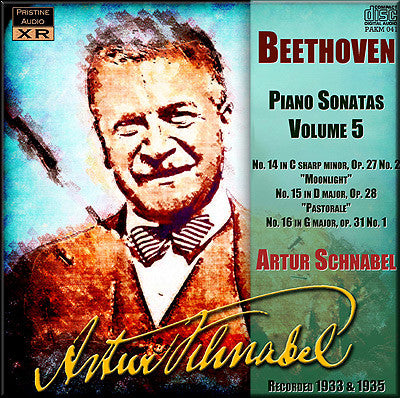
This album is included in the following sets:
This set contains the following albums:
- Producer's Note
- Full Track Listing
- Cover Art
The legendary Schnabel Beethoven series continues
"They embody what may well prove to be the sonically finest transfer
that these recordings from the 1930s have received" Fanfare
This set of sonatas has presented one of the greater challenges in the series so far, with the difficulty of reconciling the sensitivity and gentleness Schnabel brings to one of the most famous sonata movements in the classical repertoire - the first movement of No. 14 which inspired the "Moonlight" epithet in 1932 from the music critic Ludwig Rellstab, who compared it to real moonlight shining upon Lake Lucerne - with the recording of it.
The problem here was of excessive surface noise. Recorded the day before the second and third movements, it seems years apart from them in technical terms, and took up much of the overall remastering time in my efforts to reduce background noise as much as possible without harming the music, such that it could be finally brought into the foreground and heard properly and clearly, something only now possible to this degree with new restoration tools unavailable to my predecessors, thanks to the onward march of digital remastering technology.
Thereafter the restoration of each movement went ahead reasonably smoothly. Except for some exceptionally quiet, single note passages, the pitch stability achieved using Capstan software on Schnabel's Bechstein is astounding, and only occasionally does a slight surface noise "fuzz" remind the listener of the vintage of these exceptional recordings.
Andrew Rose
-
BEETHOVEN Piano Sonata No. 14 in C sharp minor, Op. 27 No. 2 "Moonlight"
Recorded 10 & 11 April 1933, issued as HMV DB 2089-90
Matrix Numbers 2B.6602-04. All 1st takes
-
BEETHOVEN Piano Sonata No. 15 in D major, Op. 28 "Pastorale"
Recorded 3 February 1933, issued as HMV DB 1953-55
Matrix Numbers 2B.2674-79. Takes 4, 3, 4, 3, 4, 3
-
BEETHOVEN Piano Sonata No. 16 in G major, Op. 31 No. 1
Recorded 5 & 6 November 1935, issued as HMV DB 3154-57
Matrix Numbers 2EA.2499-2505. Takes 1, 3, 2, 3, 2, 3, 3A
Artur Schnabel piano
Gramophone Historic Review
Every page pulses with a vividness and rough-hewn vitality that are somehow pure Schnabel, pure Beethoven...
"How characteristic is that gruff but musicianly refusal in Op. 27 No. 2 of all undue solemnity, all notion of romantic, moonlit effusion. Such robust eloquence will hardly appeal to those who long for a prolonged gaze into the infinite (the first movement is over almost before you realize it), but the balance of sense and sensibility provides a superbly authoritative alternative. Of course, there are moments when Schnabel's impetuosity, his embattled rather than fluent resolution of purely pianistic problems, can cause momentary confusion. As the opening Allegro of the Pastoral Sonata approaches its climax he loses his grip on the lefthand quavers, and in the whirling finale of Op. 31 No. 3 altogether too many corners are taken on two wheels. Yet the odd snatched phrase or telescoped rhythm pales into oblivion when you consider Schnabel's overall achievement, his salty brio and the profound eloquence of his slow movements...
His technique, while undeniably erratic,
was, in the words of his distinguished student, Claude Frank, "so
brilliant"; and every page pulses with a vividness and rough-hewn
vitality that are somehow pure Schnabel, pure Beethoven... Time and
again he wears his immense learning lightly and in, say, the dazzling
wit and repartee of Op. 31 No. 1 the dust of ages seems to fall away
before one's very eyes and ears."
From Gramophone, November 1994

